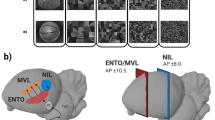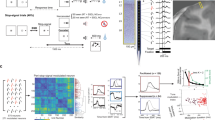Abstract
THROUGHOUT the animal kingdom, the sight of a rapidly approaching object usually signals danger and elicits an escape response1–6. Gibson7suggested that the symmetrical expansion of an object's image (looming) is the critical variable determining that the object is on a collision course with the observer. Similarly, large expanding flow-fields like those produced by locomotion may precipitate manoeuvres such as turning or landing8,9. From such observations it has been shown that the optic flow parameter, T which specifies time to contact with the approaching object best fits the behavioural data10,11. We describe a subpopulation of neurons in the nucleus rotundus of the pigeon brain that respond selectively to objects moving on a collision course towards the bird. These neurons give their maximum response at a constant time before contact occurs, even when the size of the stimulus or its velocity is varied widely. We propose that these neurons are signalling the time to collision of approaching objects.
This is a preview of subscription content, access via your institution
Access options
Subscribe to this journal
Receive 51 print issues and online access
$199.00 per year
only $3.90 per issue
Buy this article
- Purchase on Springer Link
- Instant access to full article PDF
Prices may be subject to local taxes which are calculated during checkout
Similar content being viewed by others
References
Schiff, W. Psychol. Monogr. 79, No. 11, (1965).
Hayes, W. N. & Saiff, E. I. Anim. Behav. 15, 102–106 (1967).
Schiff, W., Caviness, J. A. & Gibson, J. J. Science 136, 982–983 (1962).
Swanson, M. T. & Gogel, W. C. Percept. Psychophys. 39, 309–326 (1986).
Martinoya, C. & Delius, J. D. Biol. Cybern. 63, 127–134 (1990).
Dean, P., Redgrave, P. & Westby, G. W. M. Trends Neurosci. 12, 137–147 (1989).
Gibson, J. J. The Ecological Approach to Visual Perception (Houghton Mifflin, Boston, 1979).
Coggshall, J. C. J. exp. Biol. 57, 401–413 (1972).
Borst, A. & Bahde, S. Naturwissenchaften 75, 265–267 (1988).
Lee, D. N. & Reddish, P. E. Nature 293, 293–294 (1981).
Wagner, H. Nature 297, 147–148 (1982).
Revzin, A. M. Brain Behav. Evol. 3, 195–204 (1970).
Frost, B. J., Wylie, D. R. & Wang, Y.-C. Vision Res. 30, 1677–1688 (1990).
Frost, B. J. & Nakayama, K. Science 220, 744–745 (1983).
Hilton, S. H. J. exp. Biol. 100, 158–174 (1982).
Loeb, G. E. & Gans, C. Electromyography for Experimentalists (Chicago University Press, 1986).
Author information
Authors and Affiliations
Rights and permissions
About this article
Cite this article
Wang, Y., Frost, B. Time to collision is signalled by neurons in the nucleus rotundus of pigeons. Nature 356, 236–238 (1992). https://doi.org/10.1038/356236a0
Received:
Accepted:
Issue Date:
DOI: https://doi.org/10.1038/356236a0
This article is cited by
-
Ultra-low power neuromorphic obstacle detection using a two-dimensional materials-based subthreshold transistor
npj 2D Materials and Applications (2023)
-
From the eye to the wing: neural circuits for transforming optic flow into motor output in avian flight
Journal of Comparative Physiology A (2023)
-
Neural Circuit Mechanisms Involved in Animals’ Detection of and Response to Visual Threats
Neuroscience Bulletin (2023)
-
A low-power biomimetic collision detector based on an in-memory molybdenum disulfide photodetector
Nature Electronics (2020)
-
Pigeons integrate visual motion signals differently than humans
Scientific Reports (2019)
Comments
By submitting a comment you agree to abide by our Terms and Community Guidelines. If you find something abusive or that does not comply with our terms or guidelines please flag it as inappropriate.



